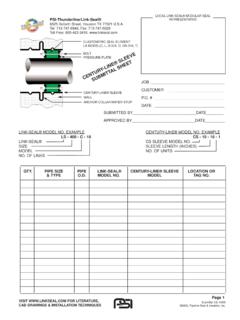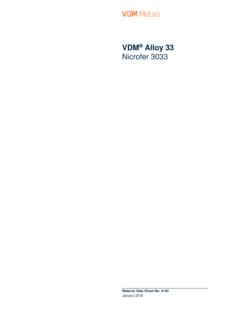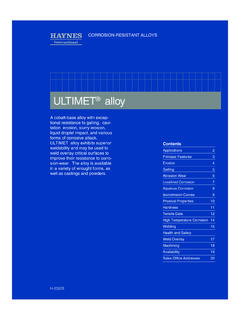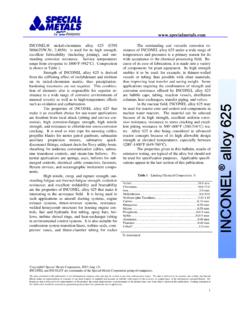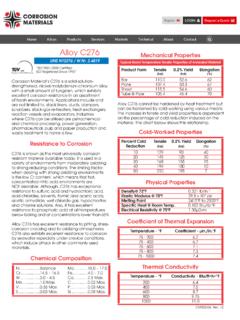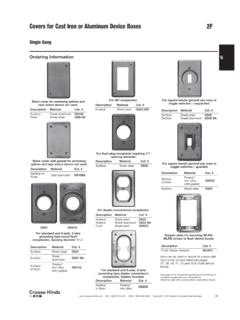Transcription of Inconel 625 Material Safety Data Sheet - GPT …
1 4990 Iris Street, Wheat Ridge Co 80033 Phone: 303-988-1242, Fax: 303-988-1922 Material Safety data Sheet Inconel 625 SECTION 1: Identification of the Substance/mixture and of the Company/Undertaking Product name: Various grades of stainless steel, nickel and titanium alloys carrying various trade names and alloy designations in basic mill product forms such as bar, Sheet , plate, and pipe. Product use: These materials are utilized in a wide variety of applications that typically involve fabrication of the alloys into useful components offering corrosion resistance, strength and a broad range of beneficial characteristics.
2 SECTION 2: Hazards Identification Solid metal alloys are not normally considered hazardous as shipped. Ends and edges can be sharp and gloves should be worn when handling. POTENTIAL HEALTH HAZARDS Skin: Although not normally hazardous, some individuals can develop allergic skin reactions to nickel and other metallic ingredients. Ends of wire and edges of strips may be sharp and can cause cuts. During welding and spraying - Fumes generated may be irritating to the skin. UV radiation produced can cause burns (ray burn). Hot metal can cause burns. Eyes: As shipped, product does not pose a hazard to the eyes however ends of wire and edges of strip are sharp and can cause cuts.
3 During welding and spraying - Fumes generated can be irritating to the eye. Ends of wire may be sharp and can cause cuts or hot and cause burns. UV radiation produced can cause burns (arc eye). Inhalation: Fumes generated by welding and spraying processes can be irritating and toxic. Ingestion: Not a likely route of entry. Metal ingestion can cause toxic effects. Delayed effects: Inhalation of welding or spraying fumes may cause damage to the lungs and respiratory tract including but not limited to fibrosis of the lung which can reduce lung capacity and produce difficulty breathing.
4 Cobalt and Nickel are animal carcinogens and inhalation of fumes and dusts should be avoided. Prolonged inhalation of Manganese fumes and dusts may cause irreversible damage to the nervous system resulting in Parkinson s Disease-like symptoms (tremors, weakness, paralysis, etc.) SECTION 3: Composition/Information on Ingredients This section lists hazardous ingredients in the as-shipped products. Nuisance particulates as respirable dust at 5mg/m3 (*Respirable Fraction)(**Crystalline Silica) (C = Ceiling Limit) (STEL Short Term Exposure Limit) 1 Composition of HAZARDOUS INGREDIENTS (as defined by OSHA and PA TITLE 34) 1% or greater by weight, except or greater for nickel and chromium.
5 2 OSHA Permissible Exposure Limits (mg/m3) 3 Threshold Limit Value (mg/m3), American Conference of Governmental Industrial Hygienist (ACGIH) Both PEL and TLV are 8 hour Time Weighed Averages (TWA), unless designated as C (ceiling limits) 4 Chemical Abstract Services Number SECTION 4: First Aid Measures Skin: Wash skin with soap and water to remove any metallic particles. If a rash or burn develops, seek medical attention. Eyes: Flush particles from eyes with clean water for at least 15 minutes. If irritation persists or burn develops, seek medical attention. Inhalation: Remove from exposure.
6 If respiratory irritation persists, seek medical attention. Ingestion: If metallic particles are swallowed, seek medical assistance. Advice to physician: Treat symptomatically SECTION 5: Firefighting Measures As shipped, these products are nonflammable and non-explosive. If subjected to fabrication by welding, however, welding arcs and sparks can ignite combustibles, and can initiate fires and explosions. Be sure you read and understand American National Standard Institute standard ANSI " Safety in Welding and Cutting" and National Fire Protection Association standard 51B for fire prevention in "Cutting and Welding Processes" before using these products.
7 Extinguishing Media Flash Point (Method Used) N/a N/a Unusual Fire and Explosive Hazards Flammable Limit N/a N/a Special Fire Fighting Procedures N/a SECTION 6: Accidental Release Measure In solid form this Material poses no special clean-up problems. If this Material is in powder or dust form, notify Safety personnel, isolate the area and deny entry. Do not sweep. Clean-up should be conducted with a vacuum system utilizing a high efficiency particulate air (HEPA) filtration system. Caution should be taken to minimize airborne generation of powder or dust and avoid contamination of air and water. Cleanup personnel should protect against exposure.
8 Properly label all materials collected in waste container. Follow applicable emergency response regulations, such as OSHA (29 CFR ). SECTION 7: Handling and Storage HANDLING PRECAUTIONS - Dust and welding fume should be moved or transported to minimize spill or release potential. STORAGE PRECAUTIONS - In solid form, these materials pose no hazards. SECTION 8: Exposure Controls/Personal Protection ENGINEERING CONTROLS - Local exhaust ventilation should be used to control exposure to airborne dust and fume emissions near the source (during welding, plasma arc cutting, sawing, grinding, etc.) below the exposure limits cited in Section 2.
9 RESPIRATORY PROTECTION - Use a fume respirator or an air supplied respirator where local exhaust or general ventilation does not keep exposure below the exposure limits for air contamination. Use NIOSH approved respirators as specified by an industrial hygienist or qualified Safety professional. Lung function tests are recommended for users of negative pressure devices. GLOVES/ARMS - Wear suitable protection while handling solid metal alloys in mill product forms to protect against physical injury. EYE PROTECTION Wear Safety glasses or goggles when there is a reasonable probability of flying particles or high levels of airborne dust.
10 If welding these materials be aware that welding arcs produce ultraviolet and infrared radiation. RECOMMENDED MONITORING PROCEDURES - The welding fumes of most of these welding products contain certain ingredients which either may, or will, reach their PEL TLV , or other occupational exposure limit before reaching the TLV -TWA of 5 mg/m3 for respirable particulate not otherwise specified (NOS). Monitoring the welding fume for these ingredients is recommended. Monitoring for respirable particulate (NOC) is also recommended for all products. Seek professional advice from an industrial hygienist or qualified Safety professional for recommended monitoring procedures.

